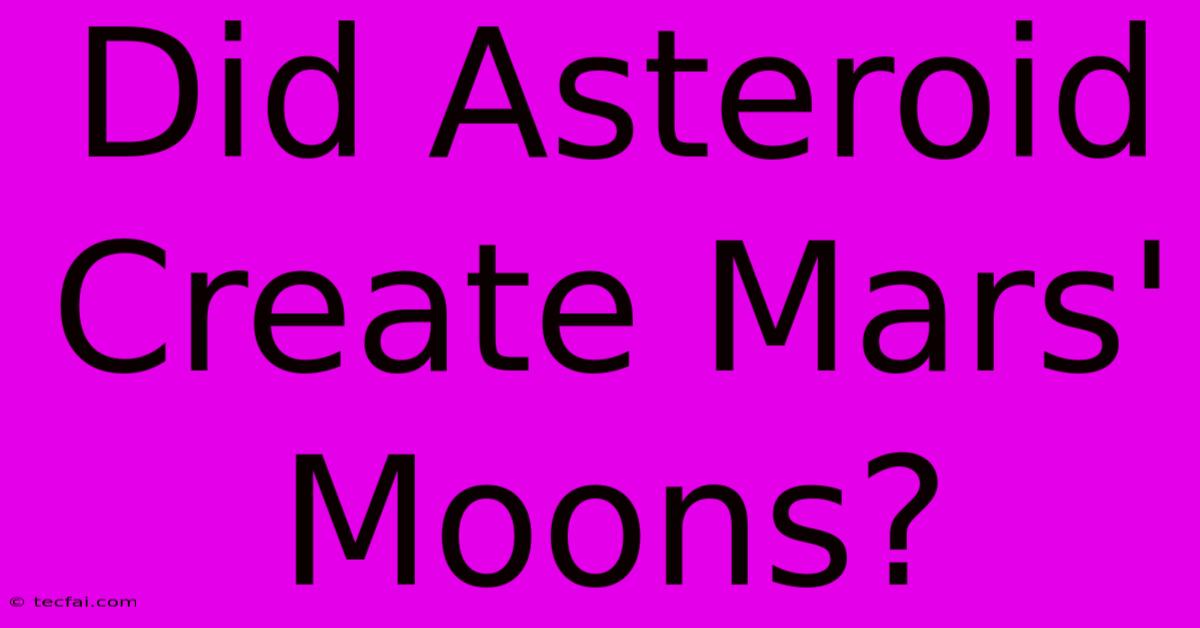Did Asteroid Create Mars' Moons?

Discover more detailed and exciting information on our website. Click the link below to start your adventure: Visit Best Website tecfai.com. Don't miss out!
Table of Contents
Did Asteroid Impacts Create Mars' Moons? A Deep Dive into Phobos and Deimos
Mars, the red planet, isn't just a barren landscape; it boasts two intriguing moons, Phobos and Deimos. Their unusual characteristics have sparked considerable debate among planetary scientists, with a leading theory suggesting they originated from a colossal asteroid impact. But is this truly the case? Let's delve into the evidence and explore the current understanding of the formation of Mars' captivating satellites.
The Curious Case of Phobos and Deimos
Phobos and Deimos are remarkably small and irregularly shaped, unlike the relatively smooth, spherical moons orbiting other planets in our solar system. This irregular shape is a key piece of evidence supporting the asteroid impact theory. Their composition also hints at an asteroidal origin. Spectroscopic analysis reveals a composition similar to certain types of asteroids found in the asteroid belt between Mars and Jupiter, further bolstering this hypothesis.
The Giant-Impact Hypothesis: A Collision Course?
The prevailing theory proposes that a massive asteroid, possibly several hundred kilometers in diameter, collided with Mars early in the planet's history. This cataclysmic impact ejected a significant amount of Martian material into orbit. Over time, this debris gradually coalesced under its own gravity, eventually forming Phobos and Deimos. This scenario explains the moons' relatively small size and irregular shapes, reflecting the chaotic nature of the debris field from which they formed.
Evidence Supporting the Impact Hypothesis:
- Compositional Similarities: The spectral analysis of Phobos and Deimos reveals a composition consistent with certain classes of carbonaceous asteroids, suggesting a shared origin.
- Orbital Characteristics: The moons' orbits are relatively close to Mars and inclined to the planet's equator, which aligns with the predictions of the giant-impact model.
- Low Density: Their low densities suggest a composition that's less dense than Mars itself, indicating the presence of significant amounts of porous material, consistent with a debris-based formation.
Challenges and Alternative Theories:
While the giant-impact hypothesis holds significant sway, it's not without its challenges. Some scientists propose alternative theories, including the capture theory, where Mars gravitationally captured pre-existing asteroids. This theory, however, struggles to fully explain the orbital characteristics of Phobos and Deimos. Furthermore, the exact details of the impact event – the size of the impactor, the precise timing, and the specific processes leading to moon formation – are still subject to ongoing research and debate.
Ongoing Research and Future Missions:
To further refine our understanding, scientists are utilizing advanced observational techniques, including high-resolution imaging and spectroscopic analysis, to better characterize the composition and structure of Phobos and Deimos. Future missions, such as sample return missions, are crucial for obtaining direct evidence that will either strengthen or challenge the existing models.
Conclusion: A Story Still Unfolding
The question of whether asteroid impacts created Mars' moons remains a fascinating and actively researched area of planetary science. While the giant-impact hypothesis currently enjoys strong support due to the observed characteristics of Phobos and Deimos, the story is far from over. Continued research and future missions promise to provide more definitive answers and help us piece together the complete history of these enigmatic Martian companions. The ongoing quest to understand their origins continues to drive scientific exploration and innovation, reminding us of the dynamic processes that shaped our solar system.

Thank you for visiting our website wich cover about Did Asteroid Create Mars' Moons?. We hope the information provided has been useful to you. Feel free to contact us if you have any questions or need further assistance. See you next time and dont miss to bookmark.
Featured Posts
-
Ravens Vs Chargers Tv Channel Time
Nov 26, 2024
-
Departing Yellen Economic Issues Persist
Nov 26, 2024
-
Tel Aviv Rocket Attack Follows Strike
Nov 26, 2024
-
Winnipeg Extends Win Streak Beats Wild 4 1
Nov 26, 2024
-
J K Dobbins Exits Game With Knee Injury
Nov 26, 2024
